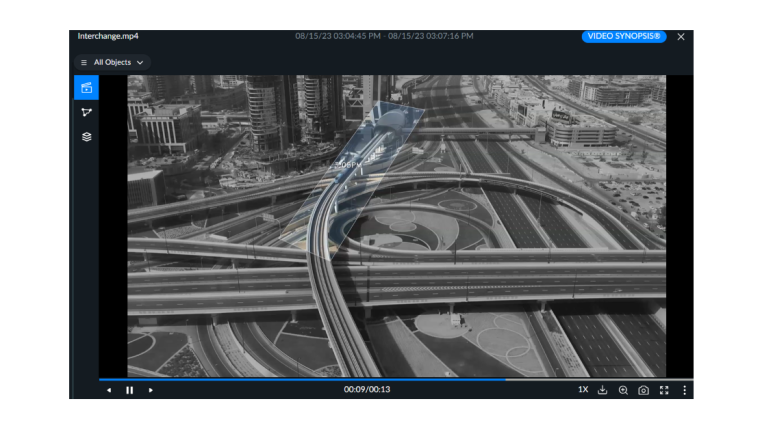Video Analytics for Life Safety Infrastructure in Mass Transit
Safety protocols within mass transit systems are evolving significantly as more people are returning to on-site work in our post-pandemic world. While working from home has become more common in recent years, before COVID-19, almost 80 % of employed persons in the EU worked on-premises, according to Eurostat.

With the workforce increasingly returning to the office, coupled with increased awareness of environmental impact, a fundamental transformation is underway regarding the convenience of commuting and our expectations of mass transit safety.
For decades, the safety framework in mass transit has relied on reactivity – responding to incidents after they occur. And though forensic search and investigation are still critical to transit safety, the model is inherently limited: Travelers are no longer content to rub shoulders with the masses and hope for the best. They expect that in exchange for their patronage, transit agencies are taking proactive measures to ensure their safety and experience.
Scaling Existing Video Surveillance Infrastructure for Proactive Safety
Implementing new, proactive safety measures is no easy task as such changes often require massive infrastructure overhaul. For this reason, many mass transit agencies are turning towards comprehensive, AI-driven video analytics for their ability to scale up on existing video surveillance infrastructure, across multiple sites. Video analytics technology identifies, classifies, and indexes objects detected in surveillance video so operators can filter and search, trigger alerts, and generate insights, thus upgrading forensic review, increasing real-time situational awareness, and generating intelligence to more seamlessly meet the demand for proactive, preventative safety.
Let’s look at how video analytics solves a few major challenges facing mass transportation agencies worldwide.
Pedestrian Crowding Trends and Vehicle Dwell Patterns
Managing the flow of people and vehicles is vital for mass transit hubs which are always one hiccup away from disrupting the commute of millions of travelers. For this reason, accurate vehicle and pedestrian traffic data is critical enablement for operations, planning, and services. Video analytics data visualizations and real-time alerts can track the number of people or vehicles in an area on an hourly, daily, or weekly basis, so transit authority planners can make informed decisions regarding safety, crowding, and bottlenecks.
Video analytics can also differentiate between vehicle types so traffic in various areas can be monitored for safety, operations, and long-term planning. For example, tracking vehicle dwell patterns can direct strategies to prevent congestion. Similarly, video analytics can uncover pedestrian crowding trends so signage can be optimized to keep travelers moving.
Subway and Railway: Preventing Track Intrusion
Track intrusion, a challenge specific to subway and railway transit hubs, encompasses actions like retrieving a cell phone, crossing to a different platform, or even laying down on the tracks. According to Eurostat, while track-intrusion related deaths have decreased since 2010, there has been a significant resurgence since 2020, signaling a huge concern for the mass transit industry in the EU. Of additional concern: this rise excludes suicide cases – of which there were 2,394 reported cases in 2022 alone. Because the strategic deployment of video analytics enables the real-time identification of behavioral patterns, abnormal activities, and entry into restricted areas, it is becoming an ideal solution for mitigating track intrusion incidents because there is generally excellent basis of camera coverage on tracks and platforms. By adding video analytics to this existing infrastructure, operators can create a virtual barrier and set a real-time, rule-based alert for people moving in a specific direction who have crossed the configured line.
When the rule is triggered, operators can immediately halt incoming trains, mobilize emergency response, and dispatch personnel to clear the tracks. Additionally, site managers can swiftly review video to understand the person’s behavior, route, and subsequent entrance onto the tracks to inform strategic changes for future events.
Business Intelligence: Using Footfall Traffic Analysis for Ad Trends
While real-time alerting and data analysis are critical for life-saving intervention and optimal operations, mass transit hubs can further maximize an investment in video analytics by leveraging the available business intelligence applications for space utilization, workforce management, and long-term leasing optimization as well. For instance, video analytics empowers footfall traffic analysis for understanding how visitors tend to reach different stores or restaurants at a station, uncovering interaction trends with ad kiosks, and quantifying unique visits that enter or bypass a tenant site. This can guide tenancy sales and pricing by quantifying the value of a particular rental space. Management can also make strategic decisions on amenities, based on rich traffic and demographic data, that will positively impact the traveler experience.
Solidifying Video Analytics as Critical Infrastructure
The integration of video analytics as indispensable critical infrastructure within mass transit systems is not merely a technological upgrade but a fundamental shift towards preemptive risk management across transit systems. Transit authorities can partner and share insight with other municipal departments to help drive their ability to anticipate, prevent, and swiftly respond to potential safety threats, thus multiplying the return on investment beyond public transit to broader public infrastructure. The metamorphosis has begun, and the proactive model for life safety in mass transit is intrinsically tied to the transformative power of video analytics.












